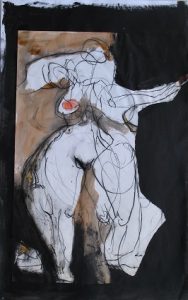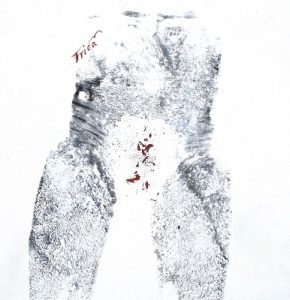It joins your thigh to your calf; your hand to your arm; your breastbone to your clavicle. As you move, it allows your muscles to glide past one another, it acts like a net suspending your organs and a high-tech adhesive holding your cells in place while relaying messages between them.

Connective tissue is one of the most integral components of the human body, indeed, one could draw a line between any two points of the body via a path of connective tissue; this network is so extensive and ubiquitous that if we were to lose every organ, muscle, bone, nerve, and blood vessel in our bodies, we would still maintain the same shape: our “connective-tissue body.” The three principle fibers found in the connective tissue are Collagen, Elastin, and Reticular.
Connective tissue is one of the most integral components of the human body.
 Despite increasing evidence of its role in chronic pain and other diseases, the connective tissue is not very well studied. I have been interested in connective tissue since I started to study deep tissue massage and Yoga postures. Both techniques were dedicated to altering the structure and layout of the connective tissue surrounding muscles and organs.
Despite increasing evidence of its role in chronic pain and other diseases, the connective tissue is not very well studied. I have been interested in connective tissue since I started to study deep tissue massage and Yoga postures. Both techniques were dedicated to altering the structure and layout of the connective tissue surrounding muscles and organs.
What’s going wrong with your body?
I would see students and patients suffering from chronic pain, often hemmed in, almost suspended in a particular postural shape. As I progressively understood, that it wasn’t just an ill habit that kept people in a certain “physical placement”. Connective tissue forms habitually, physical habit and mental input i.e. stress bring the stabilizing ingredient collagen to form a particular structure around the supporting muscles. If this structured web is tense and enclosing, the body will comply, submitting itself to the limitation, then habit forms and solidifies the tissue condition. Thus the body develops a dysfunctional posture.
Connective tissue has been relegated to the role of passive viscoelastic material in traditional biomechanical models, but researchers are now beginning to demonstrate just how many systems of the body may be affected by mechanical changes in connective tissue, and some of these findings are beginning to inform clinical practice.
The importance of connective tissue
 Connective tissue is something of an orphan child in medicine: although it is an integral part of the musculoskeletal system, the connective tissue is absent from orthopedic textbooks, which deal principally with bones, cartilage, and muscles. Orthopedic interest is almost exclusively restricted to the “specialized” connective tissues such as tendons and ligaments, which connect bone to muscles and other bones, respectively. Non-specialized connective tissues, which form what’s known as the fasciae and envelop all muscles, nerves, bones, and blood vessels, are typically allotted a short paragraph in current textbooks if mentioned at all.
Connective tissue is something of an orphan child in medicine: although it is an integral part of the musculoskeletal system, the connective tissue is absent from orthopedic textbooks, which deal principally with bones, cartilage, and muscles. Orthopedic interest is almost exclusively restricted to the “specialized” connective tissues such as tendons and ligaments, which connect bone to muscles and other bones, respectively. Non-specialized connective tissues, which form what’s known as the fasciae and envelop all muscles, nerves, bones, and blood vessels, are typically allotted a short paragraph in current textbooks if mentioned at all.
Getting a deeper inside on cells
 However, interest in the field has been growing. One area that has attracted many researchers at the cellular level is the study of mechano-transduction: how the integrin family of adhesion molecules forms a physical and informational link between the extracellular matrix and the interior of cells. Through these cell-matrix connections, cells sense forces and transform these mechanical signals into cellular responses such as the activation or deactivation of signaling molecules, translocation of transcription factors into the nucleus, and ultimately, changes in gene expression.
However, interest in the field has been growing. One area that has attracted many researchers at the cellular level is the study of mechano-transduction: how the integrin family of adhesion molecules forms a physical and informational link between the extracellular matrix and the interior of cells. Through these cell-matrix connections, cells sense forces and transform these mechanical signals into cellular responses such as the activation or deactivation of signaling molecules, translocation of transcription factors into the nucleus, and ultimately, changes in gene expression.
Fibroblasts are the cells that are responsible for synthesizing all the proteins that make up the extracellular matrix.
These cells reside within the matrix they create, responding to mechanical stimulation by regulating the amount of collagen and other matrix proteins produced, and by secreting matrix-degrading enzymes in response to chronic changes in tissue forces. Such changes can be induced by repetitive motion and are thought to be an important factor in work-related musculoskeletal injuries such as tendinitis of the shoulder or wrist.

Fibroblasts also play a major role in the response to acute injury. During chronic inflammation, myofibroblasts can drive an excessive deposition of collagen, and the increased tissue tension can result in the development of tissue contractures that restrict full range of motion. This response is also thought to play a role in the development of some types of tissue fibrosis and cancer.
Indeed, fibrotic, or scarred tissues, become stiffer, and cancer cells have been shown to spread more easily on fibrotic matrices. It appears that the key is to keep the connective tissue moving. Exercise especially slow stretching will help the deep tissue to lose dysfunctional habits. Reducing mental and postural stress will assist this process. Deep tissue massage can release not only damaged or scarred tissue but also can get the body back to unrestrained movement.

